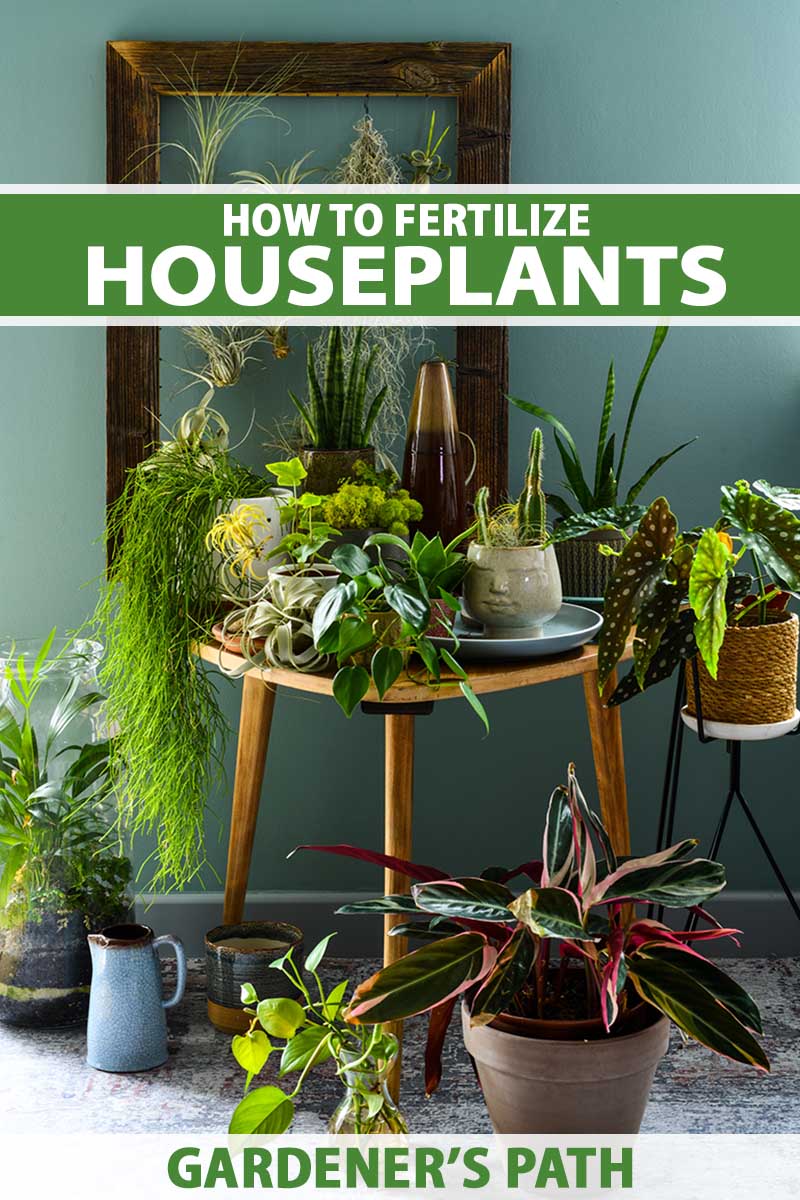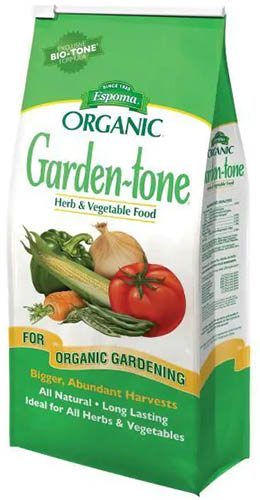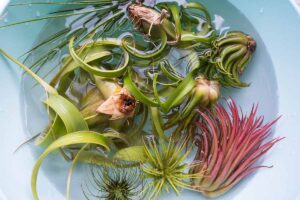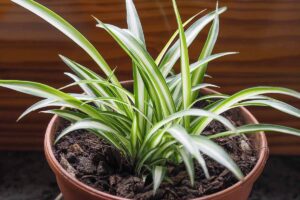In many ways, your home is a controlled environment, similar to other forms of indoor agriculture.
Indoor gardeners are able to ensure proper soil moisture, light conditions, and temperature for the plants that grow in our homes.
It is also important to supply proper nutrition for your houseplants, as they require macro- and micronutrients just like any other plant.
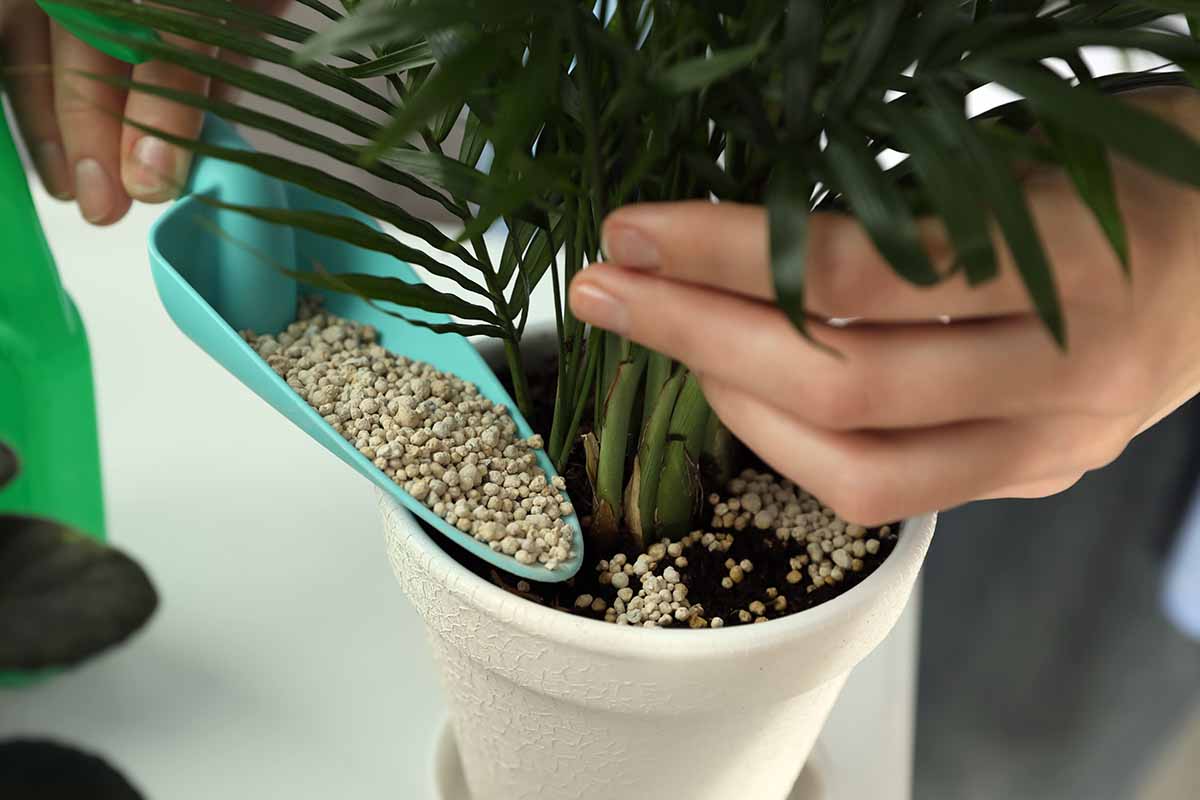
We link to vendors to help you find relevant products. If you buy from one of our links, we may earn a commission.
Plants living in your home likely grow in relatively small pots compared to those growing outdoors in the garden, and the nutrients in the soil can become depleted quite easily.
In this article, you will learn the basics of plant nutrition, fortifying houseplant soil, fertilizing your flora while watering, and how to identify possible nutrient deficiencies.
Here’s what we’ll cover:
What You’ll Learn
Nutrients that Plants Need
Plants require nutrients for basic biological functions, just like any other organism.
They are able to biosynthesize sugars, fats, and proteins – however, they can’t make mineral nutrients.
Mineral nutrients are separated into two basic categories: macro- and micronutrients.
Macronutrients
There are three nutrients that plants need the most, called primary macronutrients – these are nitrogen (N), phosphorus (P), and potassium (K).

Store-bought fertilizers are typically marked by a series of three numbers. A common label is 10-10-10. These numbers describe the relative weight percentage of nitrogen, phosphates, and potassium – often noted with the abbreviation “NPK.”
Nitrogen is essential for the biosynthesis of proteins, and it is a central component of chlorophyll, the green pigment that facilitates photosynthesis. Fertilizers with relatively high nitrogen content can be utilized to encourage rapid growth and foliage development.
Phosphorus is needed for photosynthesis and energy transfer. Growers may use fertilizer with high phosphorus levels for young specimens to promote root development, and later for flower, fruit, and seed formation.
Plants use potassium to mobilize water and nutrients throughout their vasculature, as well as for the activation of many enzymes.
Fertilizers high in potassium are often used to help plants with their water utilization. This can include mitigating drought or helping plants with their internal water pressure.
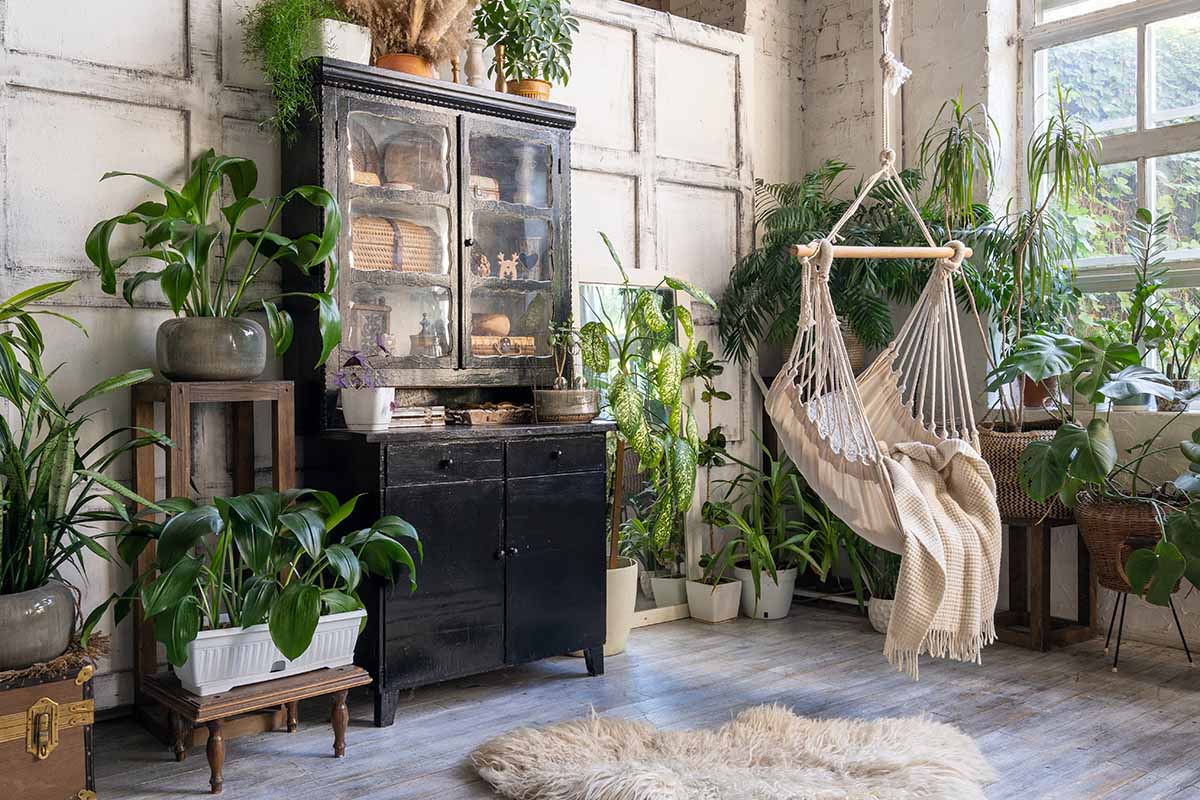
The application of primary macronutrients by growers can vary depending on the species of plant and its growth stage.
There are also three secondary macronutrients required in smaller amounts. These are calcium, magnesium, and sulfur.
Calcium is essential for maintaining the structure of cell walls, protecting the plant from external stressors. Magnesium and sulfur are involved in chlorophyll synthesis, which is essential for photosynthesis.
For my houseplants, I typically try to avoid flowering and fruit development, as I grow most of my specimens for their foliage.
For this reason, I tend to use fertilizers that are not too high in phosphorus, with a greater emphasis on nitrogen.
If you see the middle number (phosphorus) increased compared to the first (nitrogen) and last (potassium) numbers on the label, I would usually avoid those fertilizers for foliage houseplants.
Instead, I would use that fertilizer for those houseplants that you want to encourage to flower.
Micronutrients
To survive and thrive, plants also need an array of other nutrients, albeit in much smaller quantities than the macronutrients. We call these micronutrients.
Essential micronutrients for plants include magnesium, boron, copper, iron, manganese, molybdenum, nickel, and zinc.
Make sure to select fertilizers that also include these micronutrients. In many cases, the first nutrient deficiencies to appear are as a result of a lack of micronutrients.
Fortifying Houseplant Soil
There are two main categories of fertilizer that you can use for your houseplants: slow release and fast release types.
Slow release fertilizers are used to fortify soils for longer periods of time, with a continuous supply of nutrients, whereas fast release fertilizers are for immediate uptake by the plant.
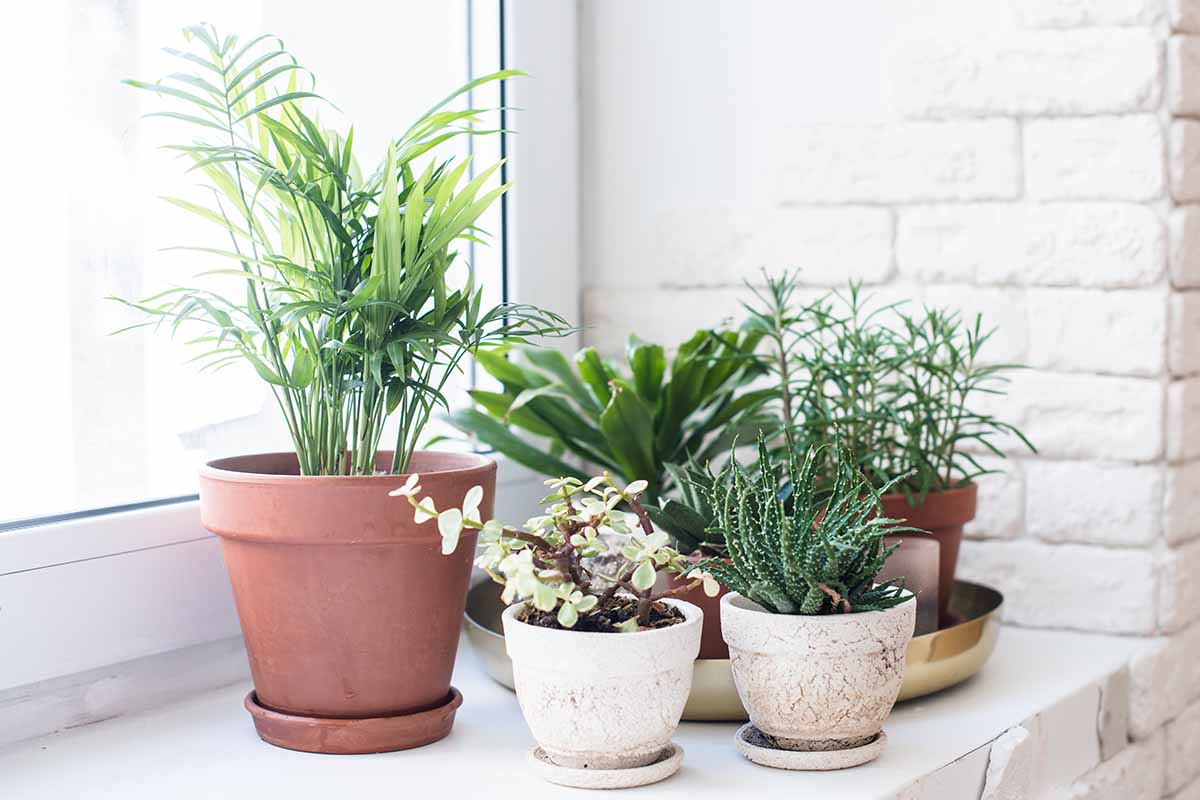
You can fortify your houseplant’s growing media by mixing slow release fertilizers into the soil. I do this whenever I repot a plant.
For most of my houseplants, I try to change the soil once a year, mixing in slow-release fertilizer while I’m at it.
Most organic fertilizers are slow release, as they consist of biological materials that take a while to break down. Organic fertilizers often naturally contain plenty of micronutrients, too.
I use organic all-purpose long-lasting, granulated fertilizers, such as Espoma Organic Garden-Tone and Dr. Earth Pure Gold.
Espoma Garden-Tone is labeled for use on vegetables, but with an NPK ratio of 3-4-4, it’s an excellent choice for houseplants. It also contains beneficial microbes to further enrich the soil.
You can find Espoma Garden-Tone available at Nature Hills Nursery in four-, eight-, and 18-pound bags.
Dr. Earth Pure Gold is a balanced product with an NPK ratio of 2-2-2.

It’s available via Amazon in one-and-a-half-pound bags.
Synthetic slow-release fertilizers tend to dissolve less quickly than organic products. Continuous release synthetic fertilizer typically comes in small, round capsules.
These are often blue or tan in color. When you are looking at these make sure you consult the label to ensure the product contains micronutrients.
When I’m repotting, and using brand new potting soil, I fortify the media with both synthetic and organic fertilizer.
I consult the label for each package, and apply a little less than half of the recommended amount for each. Together, both fertilizers combine for a near full dose of nutrients.
I like to err on the side of “less is more” when it comes to fertilizer application. You can always add more!
For my more sensitive plants, such as cacti or orchids, I apply very little fertilizer to the growing media, and generally use a liquid product.
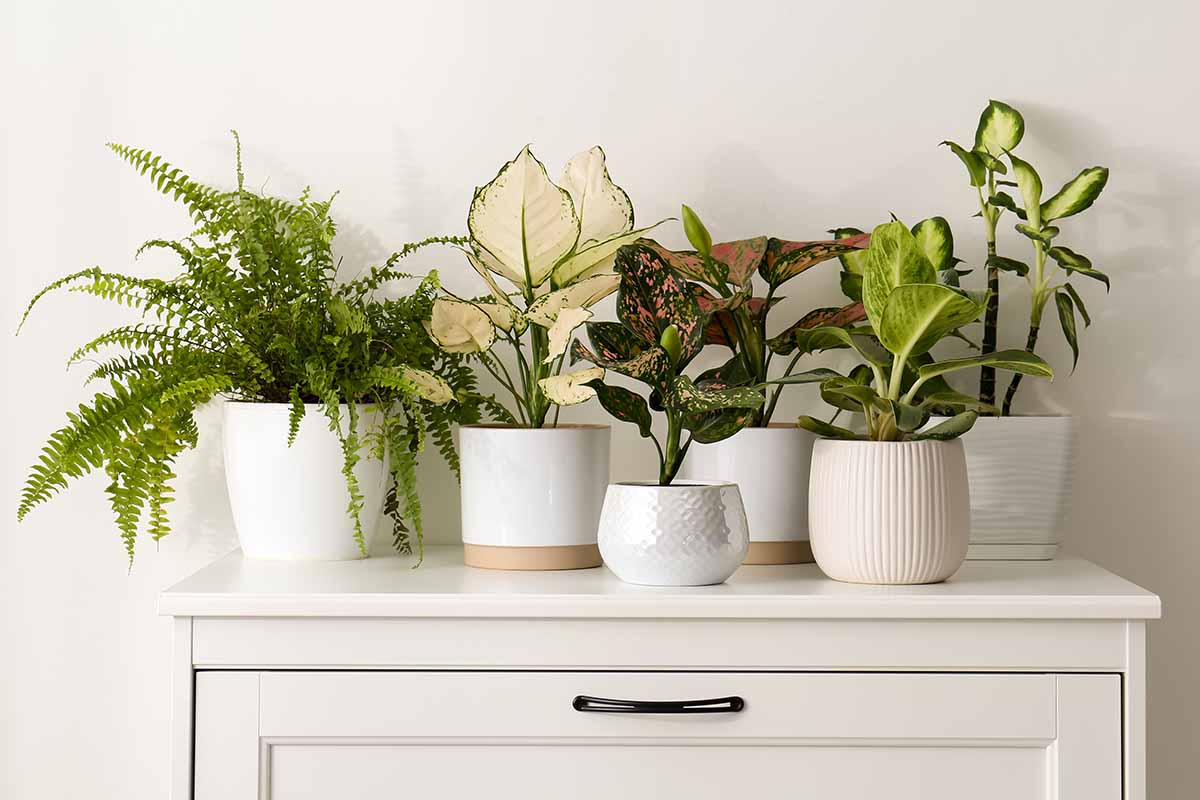
Sometimes a houseplant might need its growing media to be replenished with nutrients, but it is not yet time to repot the plant, so it can be difficult to mix in slow-release fertilizer. It is times like this when I sprinkle some capsules or organic granules on the top of the soil.
After several months, you can tell when the synthetic capsules are spent as they appear to be deflated.
Once most of the capsules have been dissolved, I sprinkle more capsules or apply organic fertilizer to the top of the soil. This helps to boost the nutrient content of the media until it’s time to repot again.
You can also use plant food spikes. These are sticks of slow-release fertilizer that you stake into the potting soil.
I use Jobe’s Fertilizer Spikes for Houseplants, which have an NPK ratio of 13-4-5 and are available in packets of 30 via Amazon.

I usually prefer to mix fertilizer uniformly throughout the growing media.
For plants like succulents that require very little fertilizer, I will sometimes place a fertilizer spike into the potting medium while watering and remove it after a day or two, to give the plants a gentle boost.
As with any fertilizer, never exceed the dose recommended on the label.
Liquid Feeding
Water-soluble fertilizers are formulated to provide immediate nourishment to your plants.
A large majority of water-soluble fertilizers are synthetic. They come in powdered or liquid forms, both of which need to be dissolved or diluted in a container of water before pouring onto the soil. Often, these products are blue in color.
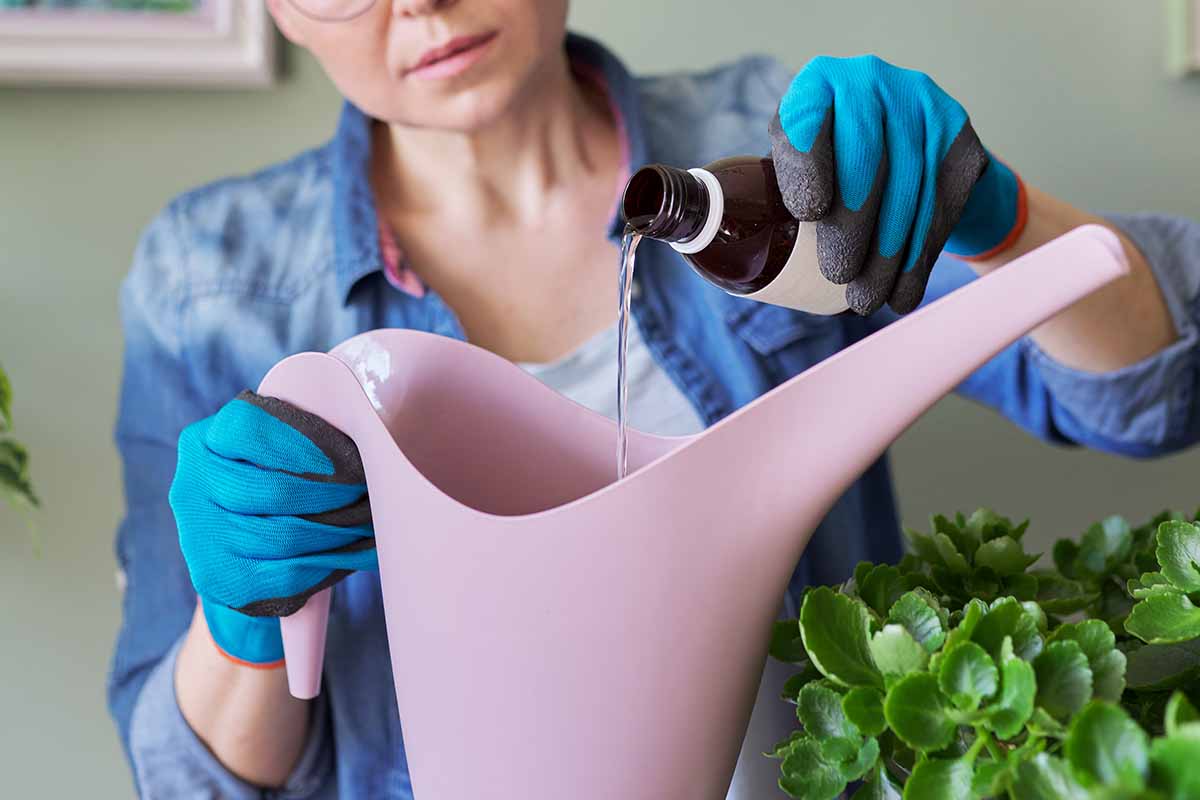
For both the liquid and powdered versions, follow the label for mixing a certain volume into your watering can.
I usually apply half the recommended amount, since I also fortify the soil with slow-release fertilizer.
A good option is Dr. Earth Pump and Grow All Purpose food. It comes in a convenient pump bottle and has an NPK ratio of 1-1-1.

You can find Dr. Earth Pump and Grow available via Amazon.
I feed my houseplants while watering about once a month in the warmer months, and once, if at all, during the winter.
Many plants undergo a pause in growth during winter, which means they will not need as many nutrients in their water.
I also buy the powder instead of the liquid. I think it is more environmentally friendly, since I can get the “liquid” water from my tap at home.
Addressing Nutrient Deficiencies
Symptoms of nutrient deficiency can vary greatly depending on the specific plant species as well as the nutrient in question.
Often, when a plant is deficient in one nutrient, it is also deficient in several others, possibly confounding the symptomatology. Which in layman’s terms means it can be hard to know exactly which nutrient deficiency is causing the problem.
General symptoms of most nutrient deficiencies include yellowing of leaves, known as chlorosis, and stunted growth. When these symptoms persist despite adequate watering, sufficient light, and no evidence of pathogens or pests, it may be time to fertilize your plants.
Houseplants may be especially prone to iron chlorosis, which is the yellowing of leaves as a result of iron deficiency.
This is because many popular houseplants come from environments with acidic soils, and if the potting soil you use is too alkaline, it will inhibit the uptake of iron.
Iron deficiency is characterized by yellowing of leaf tissue except for the veins. You can supplement iron-deficient plants with a chelated iron product or blood meal.
If you suspect your houseplant soil is too alkaline, you can add sulfur products to make it more acidic. Or simply repot into a more suitable potting mix.
Make sure you research the species you are growing to check whether or not it requires acidic soil.
Houseplants are also especially prone to magnesium deficiency, as magnesium leaches from the soil with every watering.
To supplement this loss in magnesium, you can add about one teaspoon of Epsom salts into one gallon of water, and use this solution to water your houseplants a couple of times a year.
You can learn more about plant nutrients and signs of deficiency in our guide.
Food for Thought
Other than adequate nourishment, houseplants can be encouraged to thrive by following a general guide for soil selection, potting containers, and other environmental factors like temperature and light.
In your own home, how do you ensure your houseplants have proper nutrition?
Take a look at the plants around your home, and see if any look as though they could use some food.
Let us know below if you have any tips for fertilizing your houseplants in the comments section below!
And for more information about caring for your houseplants, check out these guides next:
